Ostbahn (German: Eastern Railway) may refer to:

The Deutsche Reichsbahn, also known as the German National Railway, the German State Railway, German Reich Railway, and the German Imperial Railway, was the German national railway system created after the end of World War I from the regional railways of the individual states of the German Empire. The Deutsche Reichsbahn has been described as "the largest enterprise in the capitalist world in the years between 1920 and 1932"; nevertheless, its importance "arises primarily from the fact that the Reichsbahn was at the center of events in a period of great turmoil in German history".
Eastern Railway or Railroad may refer to:
Südbahn may refer to:

The Kingdom of Bavaria was a German state that succeeded the former Electorate of Bavaria in 1806 and continued to exist until 1918. With the unification of Germany into the German Empire in 1871, the kingdom became a federated state of the new empire and was second in size, power, and wealth only to the leading state, the Kingdom of Prussia.

The Prussian Eastern Railway was a railway in the Kingdom of Prussia and later Germany until 1918. Its main route, approximately 740 kilometers (460 mi) long, connected the capital, Berlin, with the cities of Danzig and Königsberg. At Eydtkuhnen it reached the German Empire's border with the Russian Empire. The first part of the line opened in 1851, reaching Eydtkuhnen in 1860. By March 1880 the total route length reached 2,210 kilometers (1,370 mi), with a main parallel route in the south via Bromberg and Thorn to Insterburg. The lines were the first part of the later Prussian State Railways.
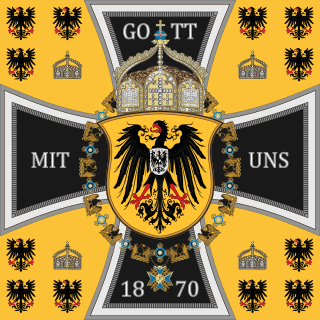
The Imperial German Army (1871–1919), officially referred to as the German Army, was the unified ground and air force of the German Empire. It was established in 1871 with the political unification of Germany under the leadership of Prussia, and was dissolved in 1919, after the defeat of the German Empire in World War I (1914–1918). In the Federal Republic of Germany, the term Deutsches Heer refers to the German Army, the land component of the Bundeswehr.
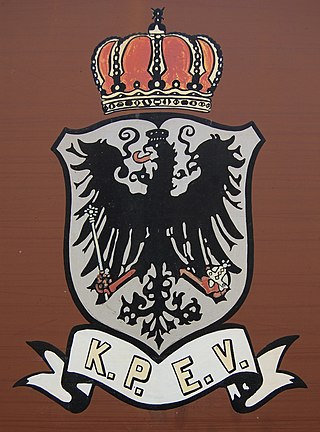
The term Prussian state railways encompasses those railway organisations that were owned or managed by the State of Prussia. The words "state railways" are not capitalized because Prussia did not have an independent railway administration; rather the individual railway organisations were under the control of the Ministry for Trade and Commerce or its later offshoot, the Ministry for Public Works.
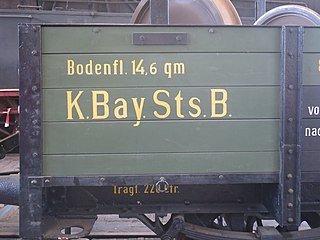
The Royal Bavarian State Railways was the state railway company for the Kingdom of Bavaria. It was founded in 1844. The organisation grew into the second largest of the German state railways with a railway network of 8,526 kilometres by the end of the First World War.
The Royal Bavarian Eastern Railway Company or Bavarian Ostbahn was founded in 1856. Within just two decades it built an extensive railway network in the eastern Bavarian provinces of Upper Palatinate (Oberpfalz) and Lower Bavaria (Niederbayern) that had previously been largely undisturbed by the railway. Much of this network is still important for local and long distance rail traffic operated by the Deutsche Bahn today.

The Bavarian G 5/5 goods train, steam locomotives were intended for steep stretches of line belonging to the Royal Bavarian State Railways network in northern Bavaria. The extremely sharp rise in the levels of traffic on these lines in the years leading up to the First World War meant that the eight-coupled Bavarian E I and G 4/5 N classes previously employed there were increasingly unable to cope.

The Bavarian Maximilian Railway was as an east–west line built between the Bavarian border with Württemberg at Neu-Ulm in the west via Augsburg, Munich and Rosenheim to the Austrian border at Kufstein and Salzburg in the east as part of the Royal Bavarian State Railways. The Munich–Augsburg section of the line had already been built by the Munich-Augsburg Railway Company and opened in 1840. The line was named after the reigning King of Bavaria from 1848 to 1864 Maximilian II.
The Bavarian Class D II was a German goods train tender locomotive with the Bavarian Eastern Railway.
In Germany and Austria, the running of railway services for a railway administration or the regional network of a large railway company was devolved to railway divisions, variously known as Eisenbahndirektionen (ED), Bundesbahndirektionen (BD) or Reichsbahndirektionen (RBD/Rbd). Their organisation was determined by the railway company concerned or by the state railway and, in the German-speaking lands at least, they formed the intermediate authorities and regional management organisations within the state railway administration's hierarchy. On the formation of the Deutsche Bahn AG in 1994 the system of railway divisions (Eisenbahndirektionen) in Germany was discontinued and their tasks were transferred to new "business areas".

Bayerisch Eisenstein/Železná Ruda-Alžbětín station is a railway station on the border of southeast Germany and the Czech Republic. It forms the junction between the Bavarian Forest railway from Plattling to Bayerisch Eisenstein, which was started in 1874 by the Bavarian Eastern Railway Company and completed by the Royal Bavarian State Railways, and the Pilsen–Markt Eisenstein railway built by the Pilsen–Priesen(–Komotau) railway in what was then Bohemia. The national border between Germany and the Czech Republic runs through the middle of the station building.

The Passau–Obertraubling railway forms a key transport link from Germany to Austria and other southeast European countries and is one of the most important main lines in southern Germany. It is double-tracked and electrified throughout.
The Deggendorf–Plattling Railway company was an early German railway company founded in 1865 with an original capital of 300,000 gulden and established to build a railway line between Deggendorf and Plattling in Bavaria, southern Germany. The capital was divided into 3,000 shares of 100 gulden each.
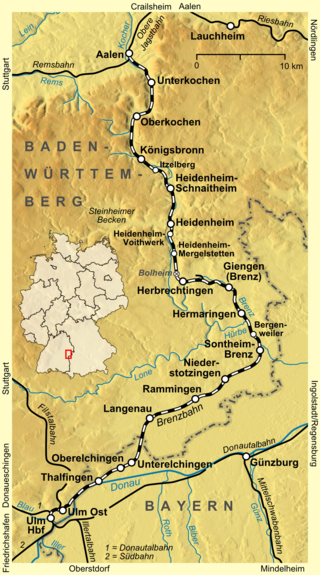
The Aalen–Ulm railway, also called the Brenzbahn or the Brenztalbahn, is a single-tracked, non-electrified main line from Aalen to Ulm in southern Germany. It is 72.5 km (45.0 mi) long and, for 27 km (16.8 mi), follows the Brenz River that gives it its name.

The history of railways in Württemberg describes the beginnings and expansion of rail transport in Württemberg from the first studies in 1834 to today.
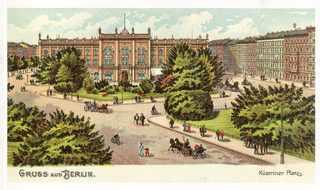
The old Berlin Ostbahnhof, more commonly referred to as Küstriner Bahnhof, was a short-lived passenger railway terminus in Berlin, Germany, opened on 1 October 1867 as the terminus of the Prussian Eastern Railway (Ostbahn) to Küstrin and Königsberg (Kaliningrad).

The Wiesau–Cheb railway was a major railway in the German state of Bavaria and the Czech Republic, which was originally part of the main line connecting Regensburg, Weiden and Eger, which was built and operated by the Bavarian Eastern Railway Company. In 1945 the line was closed at the border and since 2000 it has been closed completely except for a 3.6 km section.